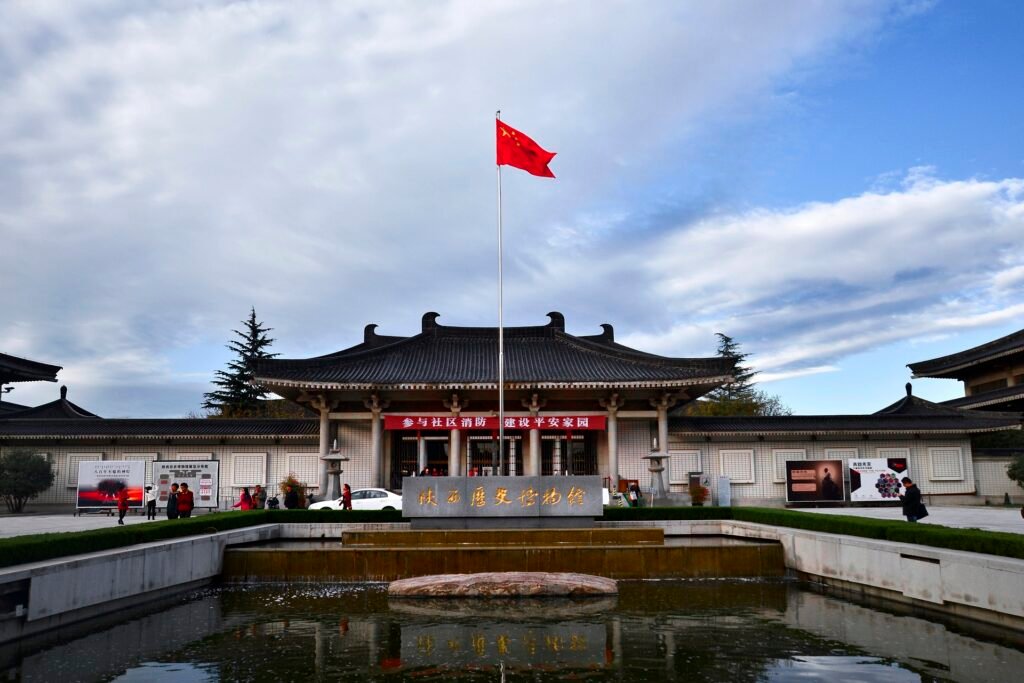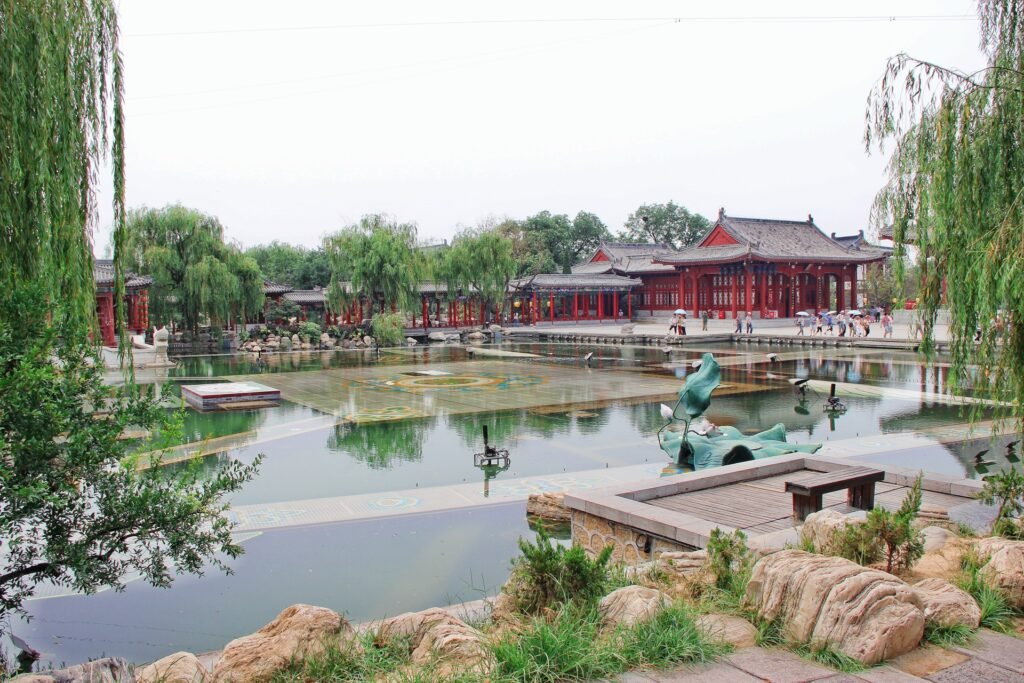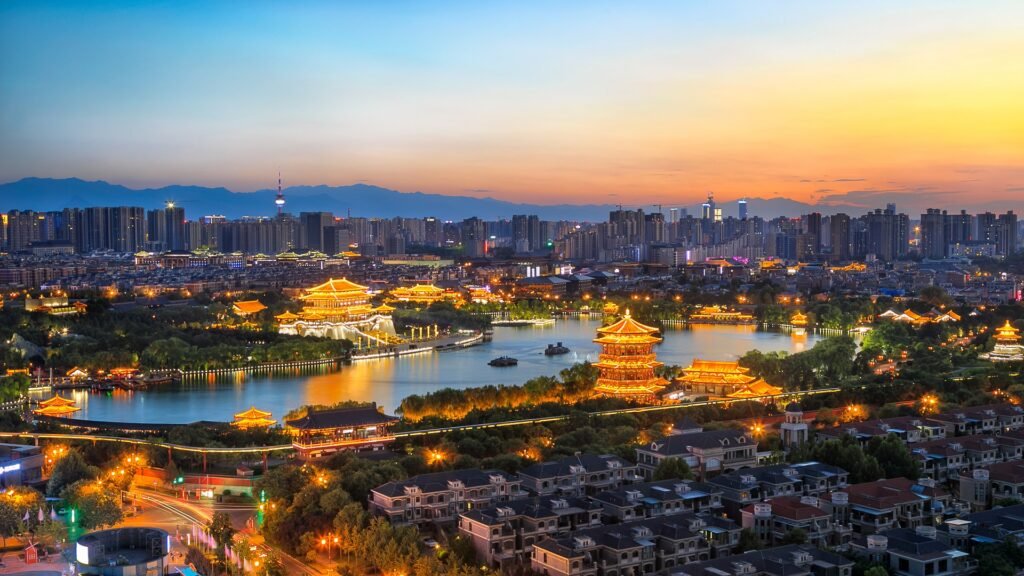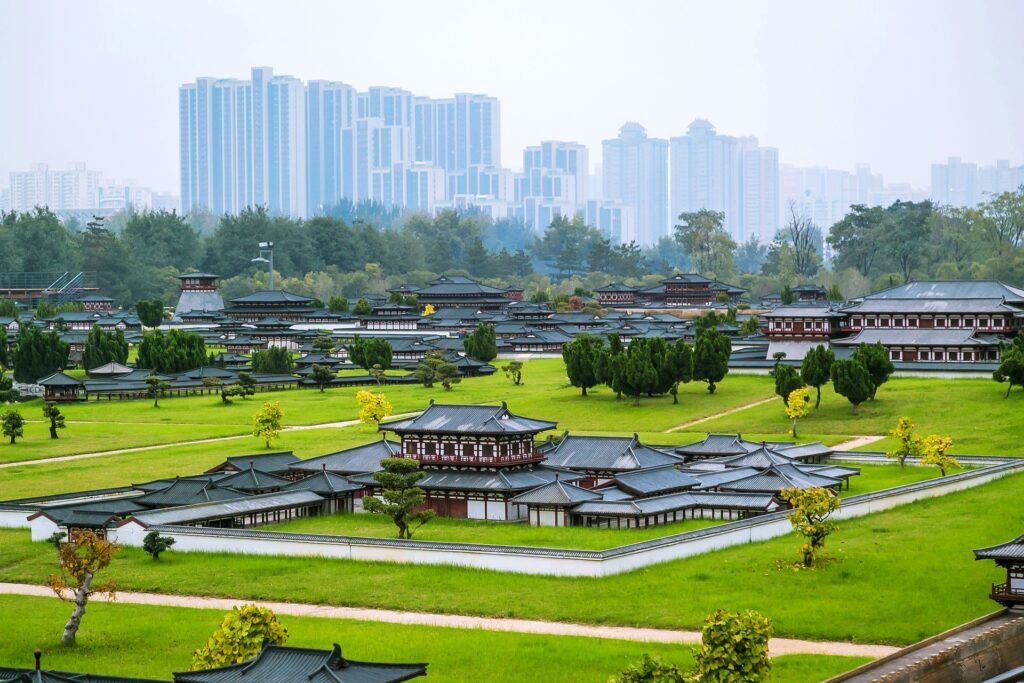Xi’an, a brilliant gem in western China, was known as “Chang’an” in ancient times. This city, which has experienced the rise and fall of 13 dynasties, is like a vast museum. Whether it’s the Terracotta Warriors, one of the world’s eight wonders, the ancient city wall that has witnessed the passage of time, or the Great Wild Goose Pagoda that once housed Buddhist scriptures from India. Every brick and tile left by our ancestors reveals the depth of history.

Why Visit Xi'an
Xi’an, witness to China’s 5,000 years of rise and fall, remains a beloved destination for global travelers. Think of the joy, excitement, and romance of experiencing the beauty of Xi’an, as expressed in the saying “With the spring breeze, I swiftly traverse the flowers of Chang’an in a single day.” How can one not fall in love with this enchanting city?
City of History
Xi’an is a renowned historical and cultural city, one of the four ancient capitals of China. It holds the record for the longest duration as a capital city, the most dynasties having been established here, and the greatest influence throughout Chinese history. It is the cradle of the Chinese nation, the birthplace of Chinese civilization, and a representative of Chinese culture.
Culinary Capital
Xi’an boasts a wide array of delicious authentic local delicacies, offering unique Northwestern flavors. Its most representative cuisine is the diverse selection of street food, including Roujiamo (Chinese hamburger), Liangpi (cold skin noodles), Yangrou Paomo (crumbled bread in mutton soup), and Suanzimian (sour and spicy noodles), leaving an unforgettable culinary experience.
City of Relics
Just as flowers bloom and wither, dynasties also experience the rise and fall. Yet, the historical relics from their glorious moments endure. Xi’an is renowned for its historical sites, including the Terracotta Warriors from the time of Emperor Qin Shi Huang, the iconic Giant Wild Goose Pagoda, and the ancient city walls.
Capital of Prosperous Tang Dynasty
Xi’an, formerly known as Chang’an, was the capital of the magnificent Tang Dynasty (618-907). During this golden era, Emperor Taizong established the “Zhenguan reign of governance,” and Emperor Xuanzong initiated the “Kaiyuan prosperity.” These pinnacle moments attracted numerous foreigners who regarded Xi’an as their second home.
City of Buddhism
Xi’an is home to many Buddhist temples such as Caotang Temple, Da Ci’en Temple, and Da Xing’an Temple. The famous landmark, the Great Wild Goose Pagoda, was built to house the Buddhist scriptures brought from India by the venerable monk Xuanzang. It welcomes visitors from around the world who seek spiritual enlightenment.
City of Arts
In Shaanxi, the most representative form of traditional art is Qin Opera (QinQiang). Compared to other operas, Qin Opera is characterized by its powerful and vigorous singing style, resembling roaring rather than conventional singing. It reflects the bold and spirited nature of the local people, encapsulating their vibrant personalities through melodic expressions.
Come and discover the wonders of Xi’an, where history, cuisine, relics, Tang Dynasty grandeur, Buddhism, and art converge to create an unforgettable experience.

Best Time to Visit Xi'an
The best time to visit Xi’an is from March to May or September to November, during the spring and autumn seasons. The temperatures during these months are pleasant, making it ideal for tourism. Summers in Xi’an can be extremely hot, with temperatures reaching over 40 degrees Celsius, while winters are very cold.
March to May
Xi’an experiences warm and dry spring weather with plenty of sunny days. It’s also the time when cherry blossoms and peach blossoms bloom. Visitors can enjoy the vibrant flowers in Xingqing Park and the Great Tang All Day Mall, and occasionally witness traditional folk performances.
June to August
Summer in Xi’an is hot with intense sunlight, and temperatures can exceed 40 degrees Celsius. If visiting during this time, especially attractions with limited shade like the Xi’an City Wall, it’s recommended to avoid the midday hours and carry necessary sun protection.
September to November
Autumn in Xi’an is pleasantly cool and the city is adorned in golden hues. The Big and Small Wild Goose Pagodas are surrounded by colorful foliage, and ancient temples like the Guanyin Temple and Da Ci’en Temple offer views of centuries-old Ginkgo trees. The streets of Bell and Drum Tower are filled with the fragrance of blooming osmanthus flowers. However, be prepared for occasional autumn showers.
November to February
Winter in Xi’an is cold, with bone-chilling winds and occasional fog. The temperatures can drop as low as -4 degrees Celsius, so it’s important to dress warmly. If lucky, visitors may experience a beautiful snowfall in the ancient city. Additionally, during this period, there are fewer tourists, and accommodation and ticket prices are lower compared to peak season.
Overall, tourism in Xi’an can be enjoyed throughout the year, and the choice of travel time should depend on personal preferences and comfort levels.
Top 13 Best Things to Do in Xi'an
Discover the vibrant city of Xi’an and explore its renowned attractions with our guide on what to do in Xi’an. From the world-famous Terracotta Army to the majestic Xi’an City Wall and cultural treasures like the Shaanxi History Museum, this ancient capital of China offers a multitude of experiences. Immerse yourself in the rich history, savor delicious local cuisine in the Muslim Quarter, and marvel at the natural beauty of Mount Hua. Get ready to embark on a journey through Xi’an’s famous places and create lasting memories.
Terracotta Army of Qin Shi Huang (¥120/person)

The Mausoleum of the First Qin Emperor is the first large-scale, well-designed imperial tomb in Chinese history. It features two earthen city walls, symbolizing the imperial and palace cities of Xianyang, and is a key cultural heritage site in China and a UNESCO World Heritage Site. The Terracotta Army Museum, including pits 1, 2, and 3, and an exhibition hall, showcases the magnificent terracotta warriors and various unearthed artifacts. Due to its vast size, it is recommended to make reservations in advance, especially during peak seasons.
Xi'an City Wall (¥54/person)

The Xi’an City Wall is the largest and best-preserved ancient city wall in China. Built on the foundation of the Tang Dynasty imperial city, it spans approximately 15 kilometers and includes features like moats and corner towers. The ancient city wall is a symbolic landmark of Xi’an, and it is particularly enchanting to explore during the evening hours. Renting a bicycle to ride along the wall provides a panoramic view of the ancient capital, but safety precautions should be taken. If planning a longer visit, it is advisable to bring sufficient water and food to avoid dehydration.
Shaanxi History Museum (Free)

The Shaanxi History Museum is China’s first large-scale modern national museum and is hailed as the “Bright Pearl of the Ancient Capital, the Treasure of the Nation.” Its collection spans over one million years, from simple stone tools used in the early stages of human civilization to various artifacts from pre-1840 society. The museum’s architectural design highlights the grandeur of the Tang Dynasty and has received awards for its excellence in architecture. It is recognized as a world-class museum by UNESCO and designated as a national key museum jointly constructed by the central and local governments.
Bell Tower (¥30/person)

The Bell Tower of Xi’an is one of the largest and best-preserved bell towers in China. It was built in the 17th year of Emperor Hongwu’s reign in the Ming Dynasty (1384 AD). Situated in the city center, it serves as a landmark and connects to the four main streets and four gates of the Xi’an City Wall.
Drum Tower (¥30/person)

The Drum Tower, built in the 13th year of Emperor Taizu’s reign in the Ming Dynasty (1380 AD), is one of the largest and most well-preserved drum towers among those remaining in China. Located near the Bell Tower, it offers a glimpse into ancient Chinese musical traditions. The bells and drums on the towers carry special significance, with the bell symbolizing the passage of time and the drum representing important messages.
Great Wild Goose Pagoda (¥50/person)

The Great Wild Goose Pagoda is located within the compound of the Da Ci’en Temple in the southern part of the city. The temple, originally built during the Tang Dynasty, was dedicated to the memory of Empress Wende and overseen by the renowned monk Xuanzang upon his return from his journey to India. The pagoda complex is vast and includes the Great Wild Goose Pagoda, the North and South Squares, among other areas. It is advisable to make reservations in advance, especially during holidays when long queues are common. The North Square of the pagoda features a musical fountain that should not be missed.
Huaqing Palace (¥120/person)

Huaqing Palace is located 30 kilometers east of Xi’an, adjacent to the world-famous Terracotta Army. It is a 5A-level tourist attraction, national key scenic spot, national key cultural heritage site, and a demonstration base for the cultural industry. Emperors of various dynasties, such as the Zhou, Qin, Han, Sui, and Tang, built their palaces and villas in this area. Huaqing Palace is renowned for its ancient hot springs, historical stories, the love story of Emperor Xuanzong and Yang Guifei, and its significance as the site of the Xi’an Incident. The palace houses several well-known attractions, including the Tang Imperial Hot Springs Museum, the historic site of the Xi’an Incident, the Jiulong Lake, and the Furong Lake Scenic Area, and the Tang Lotus Garden Ruins Museum.
Tang Paradise (¥120/person)

Located southeast of the Great Wild Goose Pagoda, Tang Paradise is a large-scale cultural theme park that replicates the architectural style of the Tang Dynasty, representing the grandeur of that era. Covering an area of 1,000 acres, including a 300-acre water area, it is the first royal garden-style cultural theme park in China that showcases the splendor of the Tang Dynasty. Visitors can admire the magnificent Tang-style architecture, enjoy the picturesque scenery accentuated by beautiful lighting, and watch the grand Tang Dynasty music and dance show, “Dream Back to the Great Tang.”
Datang Everbright City (Free)

Datang Everbright City is a comprehensive shopping, dining, entertainment, leisure, tourism, and business complex. It is centered around the Great Wild Goose Pagoda and includes three theme squares: Xuanzang Square, Zhenguan Cultural Square, and Kaiyuan Celebration Square. With its six Tang-style blocks and cultural landmarks like the Xi’an Concert Hall, Xi’an Grand Theater, Qujiang Cinema, and Shaanxi Artists Gallery, it also features a central sculpture pedestrian street spanning approximately 1,500 meters. The street showcases nine groups of sculptures representing the magnificent emperors, historical figures, heroic stories, and classic artworks.
Daming Palace (¥60/person)

Daming Palace, established in the eighth year of the Zhenguan era during Emperor Taizong’s reign (634 AD), covers an area of approximately 3.2 square kilometers. It was the grand palace of the Tang Dynasty, serving as the political and symbolic center of the empire. Situated north of Chang’an (present-day Xi’an), it is the largest of the three main palaces in the city (Daming Palace, Taiji Palace, and Xingqing Palace). Visitors can appreciate the restored miniature scenery of Daming Palace, watch the IMAX 3D film “Legendary Daming Palace,” and experience archaeological excavations and restoration of cultural relics.
Muslim Street (Free)

The Muslim Street is the gathering place of the Hui ethnic group in Xi’an and is known locally as “Huifang.” It is a must-visit destination for first-time visitors to Xi’an. The streets are lined with a variety of food stalls, allowing visitors to experience the rich cultural heritage while enjoying delicious local cuisine. With nearly 300 types of characteristic snacks available, such as roujiamo (Chinese hamburger), Southeast Asian rice cakes, yangrou paomo (muttonsoaked bread), and liangpi (cold noodles), the Muslim Quarter offers a culinary adventure that will leave visitors wanting more. It tends to be crowded, especially during holidays, so be prepared for some hustle and bustle.
Yongxingfang (Free)

Yongxingfang is a place where various delicious foods can be found, akin to a commercial food court. It’s a great place to stroll and indulge in local cuisine. The area exudes an ancient charm, and it is where the famous “Bowl Dropping Wine” originated. For a small fee, you can experience the unique tradition while a staff member captures the moment.
Mount Hua (Peak Season: ¥160, Off-peak Season: ¥100)

Mount Hua is one of China’s renowned Five Great Mountains and is often referred to as the “most precipitous mountain under heaven.” It consists of the Hua Mountain Scenic Area and five main peaks: East, South, West, North, and Central. With over 210 scenic spots, including the Plank Road in the Sky, Eagle-Soaring Cliff, and Thousand-Foot Precipice, Mount Hua offers breathtaking views. Additionally, there are 72 half-hanging caves and over 20 Taoist temples, with YUquan Temple and DuLong Temple being recognized as national key Taoist temples. For more information about Mount Hua, you can refer to our previous blog post on the top 10 famous mountains in China.
Conclusion
In conclusion, Xi’an stands as a shining gem in western China, captivating visitors with its rich history and cultural wonders. From the awe-inspiring Terracotta Army to the grandeur of the ancient city wall, Xi’an showcases the legacy of its 13 dynasties. The city’s culinary delights, vibrant markets, and serene temples add to its allure. Whether you’re a history enthusiast, a food lover, or an adventurer seeking natural beauty, Xi’an offers a diverse array of experiences. Immerse yourself in this living museum and let Xi’an’s charm and grandeur leave an indelible mark on your travel memories.



